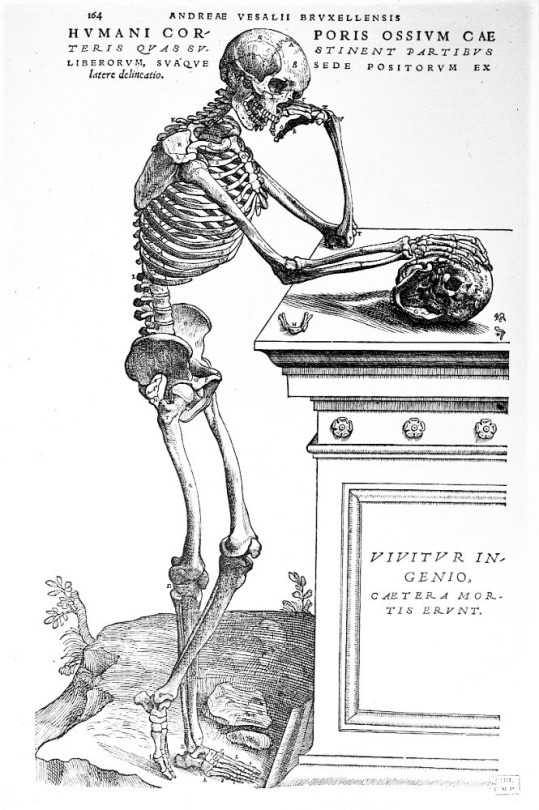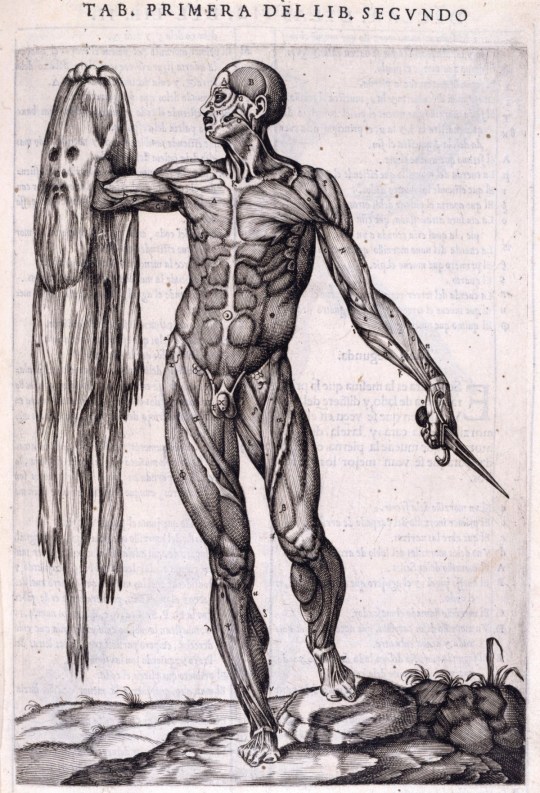#jan van calcar
Explore tagged Tumblr posts
Text


Portrait of Melchior von Brauweiler (Venice 1540), by Jan van Calcar, oil on canvas, Louvre
#art#italian art#venetian school#venice#italian painter#portrait#renaissance#16th century#jan van calcar
3 notes
·
View notes
Text

Andreas Vesalius (Brussels, Andris van Vessel 1514-1554) by Jan Steven van Calcar (1499-1546)
#paintings#art#16th century#portrait#italian art#italian painter#renaissance#jan van calcar#hermitage#museum
5 notes
·
View notes
Text

Tiziano Vecellio and Jan van Calcar, illustration for Andrea Vesalius’ de humani corporis fabrica
39 notes
·
View notes
Text





Jan Stephan van Calcar (1499-1546?) - Illustrations from Andreas Vesalius' 'De humani corporis fabrica libri septem', 1543
source
#jan stephan van calcar#de humanis corporis fabrica#skull#skulls#skeleton#skeletons#bones#anatomical art#anatomical illustration#illustration#illustrations
314 notes
·
View notes
Text

Portrait of a Young Bearded Gentleman, circa 1546-1548 Jan Stefan van Calcar (1499–1546, Italian, German-born)
#dianthus#carnation#painting#portrait#italian art#16th century painting#16th century art#Jan Stefan van Calcar
1 note
·
View note
Text







Assemble- Mind map
This is my mind map for the project assemble. I'm looking into the very literal definition of assemble in terms of something like the body. I looked at possible things I could study such as bones, the make up of the human body, skin, muscles, the makeup of the face etc. All of these I will be studying in some art pieces.
I also looked at the assembly in terms of people. The assembly of people in terms of groups, societies, communities, friends and partners. Its a lot less physical and I feel as though I would have more freedom and it would be more of an open topic for me to explore.
I researched the artist Jan Stefan Van Calcar, who tutored under Titian. he loved studying the human anatomy. He observed organs, muscles, and bones. every aspect of the body was analysed by him. here are a few of his select works: "Study of human bones" in red chalk and the rest can be found in his book "Of the study of the human body."
2 notes
·
View notes
Photo


Pierre Poncet (1574-1640) - A posthumous portrait of Andreas Vesalius
Attributed to Jan van Calcar - Portrait of Andreas Vesalius from his De humani corporis fabrica (1543)
29 notes
·
View notes
Text

Portrait of Andreas Vesalius' by Jan Van Calcar. Andreas Vesalius (1514 – 1564) was a 16th-century anatomist, physician, and author of one of the most influential books on human anatomy, De Humani Corporis Fabrica Libri Septem (On the fabric of the human body in seven books). Vesalius is often referred to as the founder of modern human anatomy.'
3 notes
·
View notes
Photo

1540 Jan de Calcar - Melchior Von Brauweiler, magistrate of Cologne
(Louvre Museum)
151 notes
·
View notes
Photo


Frontispicio de De humani corporis fabrica, de Andries van Wesel- Jan van Calcar (1543)
#frontispicio#de humani corporis#andries van wesel#jan van calcar#1543#tumblr#ilustrador#ilustración
6 notes
·
View notes
Photo

Jan Joest van Calcar (1450 - 1519) - The Resurrection.
45 notes
·
View notes
Photo




Portrait of Melchior von Brauweiler
Hi everyone ! This is a portrait of Melchior von Brauweiler, a magistrate and alderman of Cologne. Is was realized by Jan van Calcar in 1540 and is on display at the Louvre Museum, Paris, France.

Happy Simming ! Jim Polygon Counts: Object: High/Medium/Low Painting: 38/none/none Additional Credits: TSRW, S4S. Faithful reproductions of two-dimensional public domain works of art are public domain.
DOWNLOAD
75 notes
·
View notes
Photo



First photo
Title: A flayed man holding his own skin
Artist/designer Attributed to: Gaspar Becerra (ca. 1520 - 1570)
Engraved by Attributed to: Nicolas Beatrizet (1515 - after 1565)
Published by Antonio Salamanca (1478 - 1562) and Antoine Lafréry (1512 -1577) From Juan de Valverde de Amusco,
Second photo
Title: Bones of the human skeleton
Artist/designer Attributed to: Gaspar Becerra (ca. 1520 - 1570)
Engraved by Attributed to: Nicolas Beatrizet (1515 - after 1565)
Third photo
Title: De humani corporis fabrica (Of the Structure of the Human Body)
John of Calcar (John Stephen Calcar) (Netherlandish, Calcar, Cleves 1499–1546/50 Naples (active Italy)
foreword on the subject
When Andreas Vesalius (1514–1564) first published his radical De humani corporis fabrica (On the Structure of the Human Body), the ancient texts of Aristotle and Galen were still judged authoritative in the medical schools of Europe. By performing his own dissections, Vesalius discovered errors in the ancient authors' teachings. The De humani corporis fabrica, which drew attention to these flaws, initially threatened the academic medical establishment but ultimately won Vesalius admiration and a post as court physician to Charles V, to whom he dedicated the volume. Carefully integrated into Vesalius' text are over 200 woodcuts executed by a skilled group of artists that may have included Jan Steven van Calcar (1499–1546), who trained in the workshop of Titian. No text on anatomy before the Fabrica had ever been illustrated so completely or so well, and although the plates are didactic in intent, they are also rich in aesthetic merit. The frontispiece shows Vesalius himself lecturing to a huge crowd in a grand interior; breaking tradition, he stands directly beside the corpse, dissecting with his own hands. A famous sequence of plates depicts a series of flayed men and skeletons, standing as though in poses of pain or contemplation, in landscapes with distant towns and low horizons. In addition to demonstrating the physical structures of the body, they imply concern for more elusive aspects of the human condition.
11 notes
·
View notes
Text
am i in a kind of truman show scenario bc yesterday i saw a guy with a graphic tee with the jan van calcar/titian illus for de humana corporis fabrica on it (the same one i posted here once bc it rocks) today i saw a girl with a lisztomania tshirt. What is going on.
#suddenly there are more ppl with extremely niche taste on my area (?)#tomorrow i might see someone wearing a vautrin tshirt and that would definitely be extremely suspicious
6 notes
·
View notes
Text

Studies of Human Bones by Jan Steven van Calcar (c. 1543)
0 notes
Photo

Coba Ritsema (1956) - 80 years young.
Jacoba Johanna (Coba) Ritsema (26 June 1876, Haarlem – 13 December 1961, Amsterdam), was a portrait painter from the Netherlands.
Jacoba, or Coba, was born in 1876 as the daughter of the book printer Coenraad Ritsema and his wife Jeanette (Jannetje) Moulijn in an artistic family with one sister and two brothers. In her family there were already a few known artists - her grandfather Jacob Ritsema was an amateur painter, her father was a lithograph and the painter and etcher Simon Moulijn was a nephew of her mother. Her brother Jacob Coenraad was studying at the Academy of Düsseldorf since his 15th year, also the age when Coba also was allowed to experience herself in the arts. However, for a girl it was not realistic to go abroad at such young age, and she was taught drawing at the Haarlemse School voor Kunstnijverheid from 1891 until 1893. Her sister Catherine tried to become a pianist (and later became violist) and her brother Johan studied lithography like his father. From 1893 until 1897 Coba studied at the Rijksacademie van Beeldende Kunsten in Amsterdam where she was taught in a special class for female artists. She was in her education a pupil of August Allebé, George Hendrik Breitner, Carel Lodewijk Dake, Fredrik Theodorus Grabijn, Jacob Ritsema (her brother), Thérèse Schwartze, and Nicolaas van der Waay. After moving back to Haarlem for a short period, she moved in 1899 to a house at Jan Luykenstraat 23 in Amsterdam, while she had her studio at the fourth floor of Singel 512. She focused herself on the still life style, and was rejected by several famous artists she had in mind as tutor - they thought they insecure Ritsema didn't need their guidance. She was a member of the Lucas Society and Arti et Amicitiae (where she was one of the first female voting members), societies around her example Thérèse Schwartze. Recognition would however follow: in 1910 she won the bronze medal at the Exposition Universelle et Internationale in Brussels, in 1912 and in 1923 she won a silver medal from the city of Amsterdam, and in 1918 she won a Royal medal given to her by Queen Wilhelmina. In 1912 the critic Albert Plasschaert mentioned the circle of friends of which Ritsema was a part to be the Amsterdamsche Joffers (Amsterdam Young ladies) - a group of young rich female artists who worked together a lot and had a joint vision on art. She became a teacher of the students Grada Jacoba Wilhelmina Boks, Lize Duyvis, Jan den Hengst, Tine Honig, Coba Surie, Hillegonga Henriëtte Tellekamp, Victoire Wirix, and Gonda Wulfse. She was not considered to be an explicit feminist, but at the same time an example of an independent woman. While focussing on still lifes and portraits, Ritsema's works were described in 1947 by critic Johan van Eikeren as if they could have been produced by a man - something that was considered to be a compliment in those years. Her work was usually well sold, although she was not such a master that she could afford to refuse to make compromises. In her portraits there is a clear difference between those of her relatives and direct connections, which are painted rather realistic, and those of models - which are usually more impressionist. Coba was close with her brother Jacob, and when he suddenly died in 1943, she took that hard - Jacob was also a painter after all, and she consulted him a lot on her work. In 1957 she won the Rembrandt prize - a prize awarded by the city of Amsterdam once every five years. At old age she remained active although her studio wasn't easy to reach for a woman at age like herself, being on the fourth floor - she had chairs placed on every floor the way up, to be able to rest on each floor while she climbed. In her final years she lived in Pro Sinecure at the Amsterdam Vondelstraat, where she died from her weak heart in 1961. She was a member of the Pulchri Studio in the Hague, as well as being a member of the Teekengenootschap Pictura. Works of Ritsema are on display in the Teylers Museum and Mesdag van Calcar, but she also had a solo exposition in the Frans Hals Museum.
16 notes
·
View notes